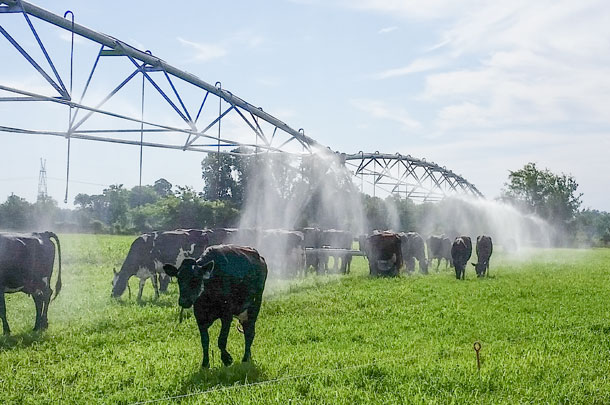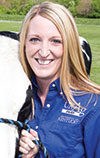Milk quality is affected by numerous factors, many of which we can control through appropriate management. One major area that encompasses many intertwined factors influencing milk quality is cow comfort, which is the focus of this article.
Consider sand or a compost barn
If you are granted the chance to build a new facility or renovate an existing one, focus on cow comfort from the start. Cows lie down for 12 to 14 hours a day, making the bedding surface on which they lie quite important. Sand is ideal because it encourages increased lying time, allows cows to transition between standing and lying easily, helps keep cows cool and doesn’t promote bacterial growth.
Bacteria are an udder’s worst enemy, and unlike sawdust or straw, sand doesn’t have organic matter that will help bacteria thrive in it. This does not mean that you can leave manure in stalls and expect the sand to take care of it. However, if you clean stalls regularly and make sure dry sand remains at curb height, there should be less opportunities for bacteria to enter the teat end when cows lie on top of it.
Compost-bedded pack barns are another comfortable option for cows because of the thick cushion they provide. The pack needs to be tilled twice daily and requires that a viable and affordable source of sawdust or shavings is available in order to support the composting process. These barns can struggle in cold weather because they need heat to be able to compost. They would do well in the southern parts of the U.S. Conversely, inadequate ventilation and a lack of fans will prevent the pack from drying properly, which will force cows to lie on wet and bacteria-laden manure and urine.
Because of their general comfort and give when transitioning between standing and lying, old and lame cows do particularly well on both sand and compost-bedded packs. However, remember a clean and dry surface is the most important thing to strive for regardless of housing or bedding type.
Pasture dairies can work
Pasture dairies are often thought as producing poorer milk quality, but there is little to no scientific basis for this theory. Lush grass and ample shade allows cows to rest in a more comfortable environment outside. Many producers want cows to calve on pasture because they think of it as being a clean and comfortable area that may help during that stressful time. So why should that not be the case throughout lactation? Heat stress is a major consideration for pastured animals. Trees can provide effective shade, but cows will often compact the area around the trees, creating a mud hole, which can increase mastitis risk. Rotating fences between shady spots or providing (and moving) portable shade structures can decrease this problem. Center pivots can also be a useful tool, allowing for evaporative cooling outside.

Guard against heat stress
Regardless of your housing type, heat stress can be detrimental to both milk production and quality. Heat stress decreases feed intake, milk production, milk components and breeding success. It also compromises the immune system, the cow’s main defense against mastitis. Bacteria thrive in hot and humid environments, so there may be more present on lying surfaces during hot periods also. Mixing immunocompromised cows with a greater number of bacteria is a mastitis disaster waiting to happen.
Cows don’t lie; so if they are showing signs of heat stress, don’t question whether it is actually hot enough for them to react that way. Try to think ahead. Consider making improvements, like hanging new fans or cleaning the old ones, in the winter when there is less fieldwork to do so that the cows are ready to take on the heat as soon as it comes.
The lactating herd is often thought of as a top priority when it comes to heat abatement, but that mindset sometimes causes other important groups to be forgotten. Of course having heat abatement tools everywhere on the farm is ideal, but is also not always economical or practical, so I recommend prioritizing heat abatement as follows: holding pen, parlor (for the cows, not the milkers), close-up dry cow area, calving or fresh cow area, high-producing group area, low-producing group area and calf area.
Although cows should not be in the holding pen more than a few hours a day, the less stressful everything around milking becomes, the more milk they will provide. Holding pens are usually one of the hottest places on dairies because cows with high body heat are packed in tightly and the pens are typically relatively closed in, which prevents heat from escaping. Remember that evaporative cooling results from air evaporating water off of the animals, not from the water itself, so make sure all facilities are well ventilated before installing sprinklers.
Helping dry cows alleviate heat will help set them up for a more successful start to their lactation, which could carry over for the whole lactation. The transition period is already extremely stressful, so adding heat stress to that mix will only further compromise the animal’s immune system, setting them up for fresh cow mastitis and other problems.
Sweat the small stuff
Skimping on the small stuff can create big messes. The best manager in the world will still have things they don’t do perfectly because there are not enough hours in the day or enough money in the bank, but striving to pay attention to as many details as possible will benefit you and your cows. Several years ago, surveys were mailed to low somatic cell count herds in Kentucky to ask what their management practices and tricks were related to milk quality. It turned out that there weren’t really any secrets – they did the things industry professionals suggest and several even stated that “attention to detail” was the key to their success. Mastitis management requires attention to detail in the parlor and in the housing system.
Building or renovating a housing system is usually a once-in-a-lifetime opportunity, so doing it right is important. When designing a new facility or improving an existing facility, remember that cow comfort plays a large role in milk quality. Build your facility for the cows, not for the workers, and you may just start to see better milk quality results. ![]()

-
Amanda Stone
- Assistant Professor and Extension Dairy Specialist
- Mississippi State University
- Email Amanda Stone
PHOTO 1: Sand-bedded stalls should be cleaned regularly, and producers should make sure dry sand remains at curb height.
PHOTO 2: Center pivots can also be a useful tool on pasture dairies, allowing for evaporative cooling outside. Photos courtesy of Amanda Stone.





